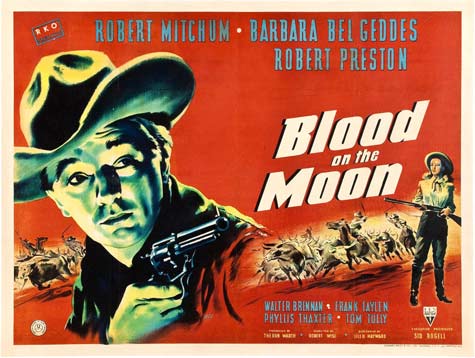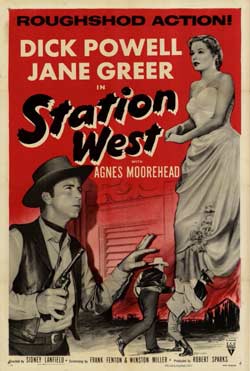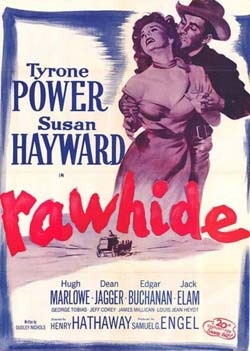 Noir is like a disease. Its symptoms are moodiness, despair, guilt, and paranoia. There were early strains of it in German Expressionism; in the crime fiction of Woolrich, Holding, and Cain; in the prewar American cinema of Welles, Ingster, and Huston. The first full-fledged outbreak started somewhere in the war years. Some say Street Of Chance in 1942; others point to Double Indemnity and The Woman In The Window in 1944. Gradually noir spread out of the crime genre, however, and attached itself to different genres. Perhaps the first victim was the cinematic stalwart, the Western.
Noir is like a disease. Its symptoms are moodiness, despair, guilt, and paranoia. There were early strains of it in German Expressionism; in the crime fiction of Woolrich, Holding, and Cain; in the prewar American cinema of Welles, Ingster, and Huston. The first full-fledged outbreak started somewhere in the war years. Some say Street Of Chance in 1942; others point to Double Indemnity and The Woman In The Window in 1944. Gradually noir spread out of the crime genre, however, and attached itself to different genres. Perhaps the first victim was the cinematic stalwart, the Western.
At first glance the Western would seem antithetical to noir. (A fetishist for strict definitions would probably insist that noir be defined essentially as a crime genre. I’m taking more of a thematic approach, here, interpreting noir as something closer to a moral thesis: that people are weak and existentially screwed.) The tropes of the Western—sunlight, open spaces, nature—would seem to immune to the noir disease. But make no mistake, the Western caught the disease. A genre that seemed to be the quintessence of American optimism, a genre that seemed to embody the notion of moral clarity, slowly gave way to darker themes and more neurotic characters.
One reason for the spread of the noir ethos to the Western is the overlap of talent between crime pictures and oaters. Noir icons like Robert Mitchum, Barbara Stanwyck, and Dick Powell all spent plenty of time out on the plains. Moreover, the behind the scenes talent—directors, writers, cinematographers—all did double duty as well.
It’s no coincidence that many early experiments came out of RKO Pictures, the company that noir historian Eddie Muller once dubbed “The House Of Noir” for its prodigious output of the dark stuff. RKO’s stable of supporting actors looks like a roll call of noir’s great goons, and most of these mugs and hoodlums popped up in dusters and six-shooters at one time or another.
Here then is a beginner’s guide to the classic Western Noir:
1. Pursued (1947): Released in film noir’s golden year, this Raoul Walsh oater stars noir’s greatest leading man, Robert Mitchum, as an orphan tormented by nightmares of his family’s death (not to mention a quasi-incestuous love for his adopted sister). With full-on noir cinematography by the great James Wong Howe, this film is one of the premiere examples of Neurosis In The West.
2. Blood On The Moon (1948): Robert Mitchum is back as a drifter caught up in the age-old land war between homesteaders and cattlemen. He’s pitted against his old pal, played by Robert Preston, and romanced by a spunky gun-wielding Barbara Bel Geddes. The team here is a who’s who of noir greats—director Robert Wise, cinematographer Nicholas Musuraca, composer Roy Webb. Hell, it even has Charles McGraw in a supporting role.
 3. Station West (1948): Underrated noir antihero Dick Powell stars as a government investigator looking into the deaths of two soldiers. The trail leads him to a sexy saloon singer played by noir goddess Jane Greer (Out Of The Past). What you have here is a film noir plot more or less transposed unaltered to a western setting, with familiar noir faces (Raymond Burr, Steve Brody, Regis Toomey) popping up in every scene.
3. Station West (1948): Underrated noir antihero Dick Powell stars as a government investigator looking into the deaths of two soldiers. The trail leads him to a sexy saloon singer played by noir goddess Jane Greer (Out Of The Past). What you have here is a film noir plot more or less transposed unaltered to a western setting, with familiar noir faces (Raymond Burr, Steve Brody, Regis Toomey) popping up in every scene.
4. Winchester ’73 (1950): Director Anthony Mann had already established himself as a master of film noir (Desperate, T-Men, Raw Deal, Border Incident) when he made the switch to Westerns. He teamed up with a revitalized Jimmy Stewart for this dark epic of revenge and obsession, as Stewart searches for the man who murdered his father. Noir regulars like Dan Duryea costarred and helped darken the Stewart persona. Beautifully photographed by William Daniels (The Naked City).
5. The Furies (1950): Another Mann masterwork. Noir icon Barbara Stanwyck stars as the headstrong daughter of a brutal cattle baron (Walter Huston). When the old man lynches her friend-and-maybe-lover (Gilbert Roland), she swears bloody revenge. Greek drama on the plains by way of a film noir aesthetic. An underrated film in many ways, for my money this shows Stanwyck at her best.
 6. Rawhide (1951): Tyrone Power stars as a train station assistant stationmaster who must match wits with a gang looking to rob the next stagecoach. Henry Hathway (Kiss Of Death) directed from a script by Dudley Nichols (Scarlet Street, Stagecoach). Features a tough as nails performance by Susan Hayward—who gets to go toe-to-toe with a wack job played by the ghoulish Jack Elam. Some fat around the edges, but in its powerful central sections this one hints at the psychological Westerns of Budd Boetticher.
6. Rawhide (1951): Tyrone Power stars as a train station assistant stationmaster who must match wits with a gang looking to rob the next stagecoach. Henry Hathway (Kiss Of Death) directed from a script by Dudley Nichols (Scarlet Street, Stagecoach). Features a tough as nails performance by Susan Hayward—who gets to go toe-to-toe with a wack job played by the ghoulish Jack Elam. Some fat around the edges, but in its powerful central sections this one hints at the psychological Westerns of Budd Boetticher.
7. The Tall T (1957): Speaking of Boetticher, he represented in many ways the culmination of the classic Western Noir in his work with star Randolph Scott. Their most renowned film was this stark thriller with Scott as a rancher forced into a battle of wills with a gang headed up by master villain Richard Boone.
8. Man Of The West (1958): This was Anthony Mann’s last foray into the Old West before he began the third phase of his career: directing costume epics. Gary Cooper stars as an ex-gunman who meets up again with his old gang and its leader, Dock Tobin (Lee J. Cobb). A dark and violent tale, it is the culmination of Mann’s noirish take on the Old West. This film also continues the psychologically complex turn in Cooper’s western heroes that began with High Noon and would conclude in The Hanging Tree a year later.
Jake Hinkson, the Night Editor, is the author of The Posthumous Man.
Read all posts by Jake Hinkson for Criminal Element.

My buddy Eric Beetner suggests THE LAST POSSE should be added to this list, and he’s right. I’m eager to hear more suggestions.
Rim Fire ( I think it may have gone by another name too- find it here:
[url=http://www.imdb.com/title/tt0041811/]http://www.imdb.com/title/tt0041811/[/url]) would fit into this category. I watched it with my mother, who loved it when she was younger, and was surprised how this moody little western stuck with me.
From over on our FB page:
David Edgerley Gates- Good list. I’d add COLORADO TERRITORY, a Raoul Walsh remake of his own HIGH SIERRA.
Johnny Guitar? Bonus is the great voices: husky Mercedes McCambridge vs soft Sterling Hayden.
Maurice– that very fine scholar– is right! I’d add Walsh’s companion piece to Colorado Territory, Along the Great Divide, and, as a noir moment, “the killing of James Earp” sequence in My Darling Clementine.
Please don’t forget RAMROD, with Joel McCrea. It is directed by Andre de Toth and costars his wife Veronica Lake. Both knew Noir very well. With much of the action occurring at night, McCrea finds himself caught between forces he cannot control, and women who seek to control him. One of McCrea’s best westerns and truly fits into the description given here of film noir.
Yellow Sky, directed by William Wellman with Gregory Peck and Richard Widmark as desperate bank robbers fleeing the law into a hellish desert to find a ghost town with an old prospector and his daughter, Mike. Full of violent, desperate characters and wonderfully filmed, this forgotten film should be shown more often. Peck is in rare ‘Duel in the Sun’ mode, rascally and devious but smitten by the stormy femme played by never-more-beautiful Anne Baxter.